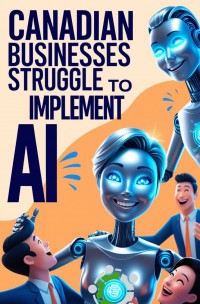MONETIZE & BOOST CONTENT
Monetizing your FREE webinars and related content has never been easier. Use our platform to list your events and onboard new affiliates as well as guests. Earn $1.00 for each new guest you onboard, share up to 70% of tipping and membership revenues and promote your webinar(s) to reach new global markets.
Drive earnings and expand reach to include listing of your webinar on upto 6,000 + event calendars, blogs and social media groups.
NINE MONETIZATION BENEFITS
- Earn $1 for each new collaborator/registration
- Share up to 70% of tipping revenues
- Share up to 12.5% of e-commerce revenues
- Share up to 50% of membership upgrades
- Share up to 30% of hosting upgrades
- Share up to 12.5% of your team's earnings
- Transform supporters into your affiliates
- Build viral fan networks
- Identify affiliates to promote your webinars
Save & Earn $10K Per Month
Canadian Businesses Struggle to Implement AI: Why Adoption is Lagging Behind
Build CollaborateAI is making waves across industries globally, but Canadian businesses are facing unique challenges that slow down their adoption. Despite growing excitement and investment in AI, companies in Canada are often stuck in lengthy implementation pipelines. Experts point toΒ cultural caution and resource limitations as key barriers, making the journey from strategy to execution much slower than in other regions, especially the U.S.
Why is AI Adoption Slower in Canada?
-
Long Implementation Pipelines:
- AI adoption can take 18-36 months in Canada, from formulating a strategy to fully implementing AI solutions. This lengthy timeline is a stark contrast to regions like the U.S., where AI is deployed much faster.
- Delays stem from complex integration processes, technical challenges, and the need for businesses to align AI solutions with their specific goals and operations. These barriers often lead to frustration and slower returns on investment.
-
Cultural Caution and Risk Aversion:
- Canadaβs cautious approach to change is often cited as a major hurdle in AI adoption. Unlike in the U.S., where bold innovation is often celebrated, many Canadian businesses take a more conservative stance when it comes to adopting disruptive technologies like AI.
- Companies in Canada are generally more risk-averse, which results in slower decision-making processes and hesitation to commit to large-scale AI projects. This reluctance can prevent businesses from leveraging AI to its full potential, especially when they are competing with more agile global counterparts.
-
Resource and Talent Shortages:
- Lack of AI talent is another significant barrier. Canada has a strong AI research community, but businesses often struggle to recruit and retain skilled AI professionals. The demand for AI experts outpaces the supply, creating a talent gap that hinders implementation.
- Additionally, AI adoption often requires significant investment in infrastructure and training, which many smaller or mid-sized businesses in Canada may find difficult to manage. The high upfront cost and complexity of AI adoption make it an intimidating prospect for many companies, especially those with limited resources.
-
The Potential of Large Language Models (LLMs):
- Large language models (LLMs), such as GPT and similar technologies, have the potential to revolutionize productivity for knowledge-based jobs. These models can assist with tasks like content creation, customer service, data analysis, and decision-making.
- However, Canadian businesses are still lagging in leveraging LLMs to their full advantage. While large enterprises may be experimenting with these models, small to medium-sized businesses are often slow to integrate this technology due to the same cultural and resource constraints.
The Path Forward:
-
Breaking Cultural Barriers: To accelerate AI adoption, Canadian businesses will need to embrace a more innovative mindset and move beyond their cautious approach to technology. This may involve fostering a culture of experimentation and risk-taking, where AI is seen as an enabler of growth, rather than a threat to the status quo.
-
Addressing the Talent Gap: Collaboration between industry and academia could be key to addressing the AI talent shortage. Canadian companies should look to universities and research institutions to create pathways for training and mentoring the next generation of AI professionals. Partnerships with global AI firms could also help fill the talent gap by offering specialized expertise and knowledge.
-
Investing in Infrastructure: Businesses will also need to make significant investments in the right AI infrastructure to support successful implementation. This includes upgrading IT systems, ensuring data quality, and providing training programs for employees to adapt to new AI tools and systems.
AI has the potential to significantly enhance productivity and efficiency for Canadian businesses, but adoption remains slow due to a mix of cultural and resource challenges.
By fostering an environment of innovation, investing in talent development, and addressing infrastructure needs, Canadian businesses can overcome these barriers and unlock the full potential of AI.
What do you think is holding Canadian companies back from adopting AI at scale? How can businesses break through these challenges? Share your thoughts and experiences below! β¬οΈ
Pamper Me Network Joins Forces With SAHOP to Launch Retireme..
Build Collaborate
145 Views 4 days ago
How Soon Should You Start Planning for Retirement? The Soone..
Build Collaborate
136 Views 4 days ago
The Retirement Crisis You Canβt Ignore: AI Offers A Soluti..
Build Collaborate
398 Views 2 weeks ago
Revolutionizing Election Technology and Voter Engagement wit..
Build Collaborate
452 Views 2 weeks ago
AI Can Compose Music & Create Amazing Art: Exploring the Cre..
Build Collaborate
373.3K Views 1 year ago
Innovating The Way You Network & Monetize Online With Social..
Build Collaborate
127.2K Views 1 year ago
Why AI is the Greatest Invention of the Last Century: Transf..
Build Collaborate
99.3K Views 1 year ago
How Can You Fund Your Crypto Or Blockchain Project: Explorin..
Build Collaborate
97.5K Views 1 year ago
General Ramos' Rule The World NFT Collection Is Now Powered ..
Build Collaborate
96.7K Views 2 years ago
MONETIZE & BOOST CONTENT
Monetizing your FREE webinars and related content has never been easier. Use our platform to list your events and onboard new affiliates as well as guests. Earn $1.00 for each new guest you onboard, share up to 70% of tipping and membership revenues and promote your webinar(s) to reach new global markets.
Drive earnings and expand reach to include listing of your webinar on upto 6,000 + event calendars, blogs and social media groups.
NINE MONETIZATION BENEFITS
- Earn $1 for each new collaborator/registration
- Share up to 70% of tipping revenues
- Share up to 12.5% of e-commerce revenues
- Share up to 50% of membership upgrades
- Share up to 30% of hosting upgrades
- Share up to 12.5% of your team's earnings
- Transform supporters into your affiliates
- Build viral fan networks
- Identify affiliates to promote your webinars
Activate Tipping, Donations & Social Rewards
Register Now
Support This Creator
Thank you [ Name of Creator ]
Email:
COPY TEXT BELOW, OPEN EMAIL CLIENT, CREATE NEW MESSAGE, PASTE TEXT FROM CLIPBOARD & SEND MESSAGE
I thought you might be interested in this content/opportunity:
You can review at
Whatsapp:
COPY TEXT BELOW, OPEN WHATSAPP, CREATE NEW MESSAGE, PASTE TEXT FROM CLIPBOARD & SEND MESSAGE
I thought you might be interested in this content/opportunity:
You can review at
Instagram:
COPY TEXT BELOW, OPEN INSTAGRAM& CREATE NEW DIRECT MESSAGE, PASTE TEXT FROM CLIPBOARD & SEND MESSAGE
I thought you might be interested in this content/opportunity:
You can review at
Skype:
COPY TEXT BELOW, OPEN SKYPE& CREATE NEW DIRECT MESSAGE, PASTE TEXT FROM CLIPBOARD & SEND MESSAGE
I thought you might be interested in this content/opportunity:
You can review at
Snapchat:
COPY TEXT BELOW, OPEN SNAPCHAT, CREATE NEW CHAT, PASTE TEXT FROM CLIPBOARD & SEND MESSAGE
I thought you might be interested in this content/opportunity:
You can review at
%20(1).jpg)


















